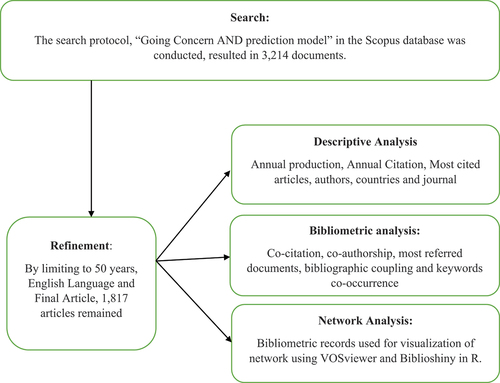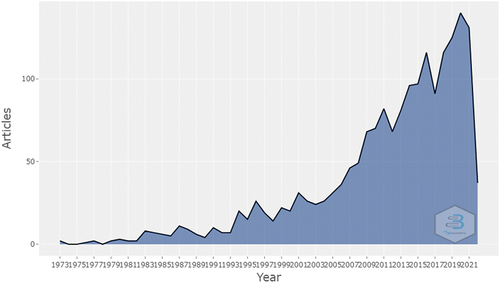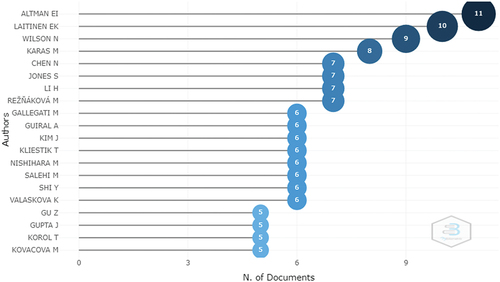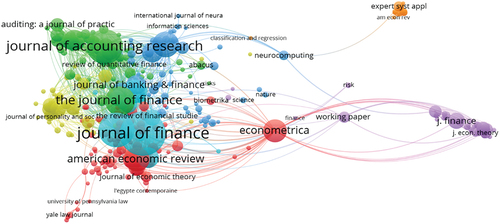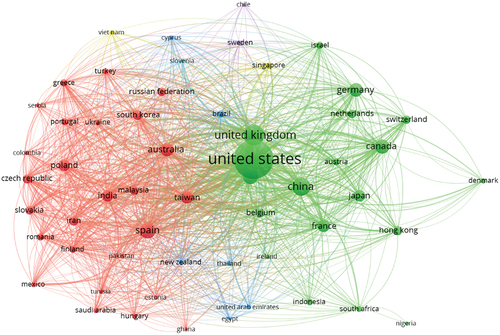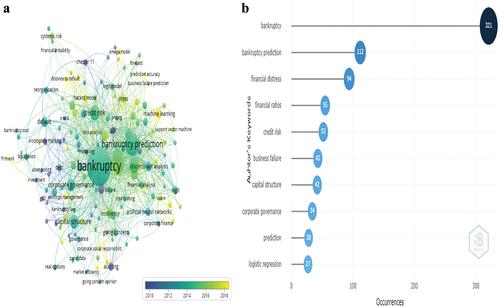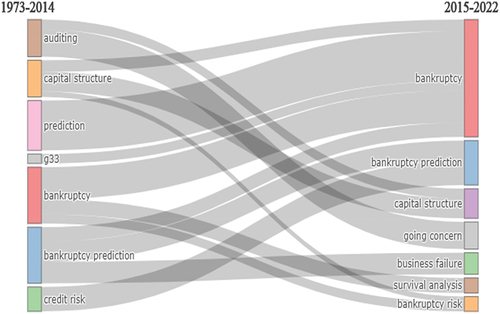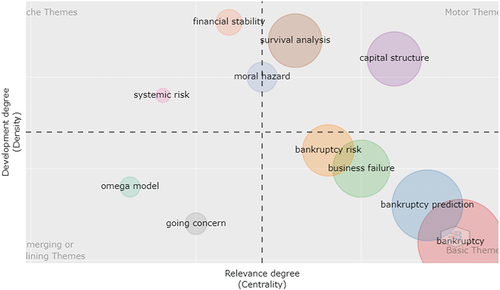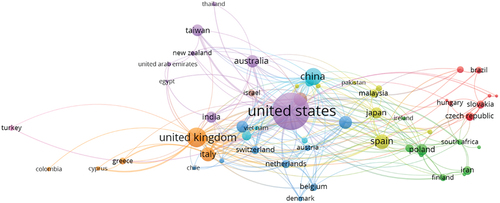Abstract
Given the global attention and attraction of many scholars and researchers to develop prediction models for determining the going concern of businesses, there is a growing need to monitor progress and trends in the field. As such, the study aims to analyse the evolution of prediction models for going concern and business failure in the literature over the past 50 years. The study used VOSviewer and the biblioshiny utility of RStadio to analyse bibliometric data extracted from the Scopus database. The results indicated that there was a slow pace in publications from the 1970s to 1999, but the number of publications increased in the 2000s and continues to increase. The study also found that many countries across the globe have significantly contributed to modelling going concerns and business failure predictions. Furthermore, the visualisation of bibliographic coupling and co-occurrence of the author’s keywords revealed knowledge drifts in the field’s interconnected publications with many collaborations. The analysis of the author’s keywords revealed key themes such as going concern probability, the omega model, and business failure probability that remained under-researched and that research attention should be directed to that areas. These findings shed light on the research trends, influential works, author contributions, global perspectives and the current state of research in the field and provide valuable insights for future studies in the prediction of going-concern and business failure.
1. Introduction
The concept of “going concern” is one of the fundamental concepts in generally accepted accounting principles (Gkouma et al., Citation2018). It assumes that, unless there is evidence to the contrary, an entity is expected to continue operating indefinitely or at least for the foreseeable future (Wójcik-Jurkiewicz & Karczewska, Citation2019). This assumption is crucial as it ensures the continuity of business operations and a steady flow of activities (Zéman & Lentner, Citation2018). The concept does not impose a specific time limit on business enterprises. As long as a business can generate sufficient revenue, it has the potential to continue operating and achieving success. Discussions surrounding the going concern concept emphasise that companies are anticipated to survive indefinitely without facing imminent bankruptcy (Wójcik-Jurkiewicz & Karczewska, Citation2019).
Given the significance of the going concern concept, stakeholders in businesses are always eager to understand the financial status of the entities involved. This is due to past instances where even large, well-established companies have experienced failure. Notable examples include WorldCom, Enron Corp., Global Crossing Ltd., Pacific Gas and Electric Co., Kmart Corp., FINOVA Group Inc., Reliance Group Holdings Inc., and Federal-Mogul Corp (Altman et al., Citation2019; Obiyo & Ezenwa, Citation2012). Additionally, the financial crisis that began in 2007 led to a significant number of business closures and increased interest in the going-concern status of entities (Benita, Citation2019).
As a result, several scholarly works have been devoted to improving the accuracy of models used to predict company failure (Isayas & McMillan, Citation2021; Pham et al., Citation2021). Addressing the persistent issue of business insolvency, researchers have devised various going concern predictors to forecast the financial status of entities (Bărbuță-Mișu & Madaleno, Citation2020; Ogachi et al., Citation2020). Different models, integrating distinct variables and techniques, have been employed by researchers to forecast the likelihood of a company filing for bankruptcy, with each model tailored to a particular industry and country (Camska & Klecka, Citation2020). The development of numerous models for predicting the future of enterprises is indicative of the ongoing efforts of researchers in this area.
The development of these predictive models can be traced back to Beaver’s (Citation1966) ground-breaking work. His univariate analysis predictor identified a number of indicators that could distinguish between unsuccessful and successful firms up to five years before the actual failure. Deakin (Citation1972) expanded Beaver’s model by employing a multivariable discriminant model in the analysis. These studies demonstrate the potential of financial ratios as predictors of future performance but fail to identify the most significant indicator. While univariate analysis is straightforward to implement, especially with smaller sample sizes, it becomes laborious and impractical when applied to larger samples. In such situations, multivariate analysis proves to be the superior method. The multivariate analysis provides a comprehensive method for simultaneously analysing multiple variables, allowing for more precise predictions and decisions.
Altman (Citation1968) introduced a multivariate framework known as the Z-Score model to predict the likelihood of a company going bankrupt. This model improved upon the previous univariate approach. The original Z-Score model consisted of 22 variables, which were subsequently condensed into five standard ratios: profitability, liquidity, solvency, leverage, and activity ratios. Notably, Altman excluded the cash flow ratio, which was a significant component in Beaver’s (Citation1966) univariate analysis. Beaver (Citation1966) found the cash flow-to-debt ratio to be the most effective individual predictor. However, Altman (Citation1968) chose not to include it in his model, citing concerns about subjectivity and the potential for manipulation to mislead the analysis. Altman’s Z-Score model employed a multivariate linear analysis approach, utilising five objectively weighted measures that were aggregated to obtain an overall score (Altman, Citation2013). The sampled firms in the study were classified as “distressed” or “non-distressed” based on the score obtained. One limitation of the Z-Score model is the absence of an absolute zero cut-off score that clearly distinguishes between the two classes. This is due to the model lacking a constant y-intercept. Despite this flaw, the Z-Score model represented a significant advancement in bankruptcy prediction through the application of multivariate analysis and the incorporation of key financial ratios. It is worth noting that the Z-Score model has undergone subsequent refinements and adaptations by Altman and other researchers over the years to enhance its accuracy and applicability in different contexts.
Following Altman’s pioneering work, a substantial body of research has focused on forecasting corporate financial distress. Taffler (Citation1977) introduced a variant model that addressed the limitation identified in Altman’s Z-Score model. Taffler’s model considered a broader set of variables, comprising eighty ratios that could be computed from financial statements. These ratios encompassed crucial aspects of corporate performance and solvency, including profitability, financial risk, liquidity, and working capital adequacy. To identify the most significant subsets of variables, Taffler employed a statistical technique called stepwise linear discriminant analysis. This process narrowed down the extensive set of ratios to the four subsets that exhibited the strongest predictive power. Unlike Altman’s Z-Score model, Taffler’s model incorporated an absolute zero, thereby providing a clear threshold for classification. In Taffler’s model, a positive score indicated sound financial management by a going concern, while a negative score signified financial challenges and potential bankruptcy. This scoring system allowed for a more precise evaluation of a company’s financial health and its likelihood of encountering financial distress. It is important to note that the field of bankruptcy prediction has continued to evolve since Taffler’s work, with subsequent studies refining and expanding upon the models and methodologies. Researchers have explored additional variables, alternative statistical techniques, and the incorporation of non-financial indicators to enhance the accuracy and applicability of bankruptcy prediction models.
In the pursuit of improved accuracy in predicting financial distress, according to Aziz and Dar (Citation2006), researchers have developed numerous models, which can be classified into three main categories as statistical models, artificial intelligence and expert systems (AIES), and theoretical models. Statistical models encompass a range of methods such as Altman’s z-score, bankometer, discriminant analysis, hazard modelling, partial least squares, logistic/logit regression and probit regression. These models utilise statistical techniques to analyse financial data and identify potential signs of financial distress. Artificial intelligence and expert systems (AIES) incorporate intelligent techniques including data mining, support vector machines, neural networks, decision trees, genetic algorithms, rough-set fuzzy logic, data envelopment analysis (DEA), Adaboost, K-nearest neighbours, and Bayesian networks. These methods leverage advanced algorithms and machine learning approaches to capture complex relationships and patterns in financial data for predicting financial distress. Theoretical models are based on theoretical frameworks and concepts. They may incorporate economic theories, financial indicators, or other qualitative factors to assess the likelihood of corporate failure. Some models combine multiple approaches, referred to as hybrid techniques. For instance, Wang et al. (Citation2021) developed a prediction model for financial distress using a hybrid approach that integrated principal component analysis, multivariate discriminant analysis, and logit. Similarly, Sun et al. (Citation2021) developed a bankruptcy prediction model using a hybrid method that combined principal component analysis, multivariate discriminant analysis, and logit. These hybrid models leverage the strengths of different algorithms and techniques to enhance the accuracy of predictions.
Given the global attention and attraction of many scholars and researchers to develop prediction models for determining the going concern of businesses (Ogachi et al., Citation2020), there is a growing need to monitor progress and trends in the field. Therefore, the purpose of this study is to provide a critical academic structured review of studies that focused on going concern and business prediction models using bibliometric tools. The bibliometric technique helps analyse large data sets as compared to other review tools. The precise objectives of the research include: (1) to analyse the contributions in terms of authorship, citation, and geographical location; (2) to identify impactful writers through citation and collaboration analysis; and (3) to examine the current trend and future direction to predict going concern and business failure.
By addressing these objectives, the study aims to contribute to the literature in some ways. Although studies on going concern and business failure have grown over the years, bibliometric reviews are limited. This study will augment existing works to offer broader understanding regarding the subject matter. Systematic reviews which dominate the reviews have focused on the determinants of going concern and business excluding the trend analysis. The trend analysis is crucial as it reveals areas that are lagging and requires further interrogation. The bibliometric review in this study provides such trend analysis.
Over all, this study contributes to a better understanding of the scholarly landscape surrounding going concern and business failure prediction. Researchers can gain insights into the growth and development of the field, identify emerging topics, and track the impact of key publications or researchers by studying the evolution of research trends over time. This was achieved through analysing publication patterns, citation trajectories, and co-citation networks. Such analysis allows for a comprehensive understanding of how the field has evolved and helps to identify new and emerging areas of study. Furthermore, it enables the evaluation of the influence and significance of important publications or researchers in shaping the field’s progress. It also provides valuable information for researchers, policymakers, and practitioners, helping to shape and guide future research directions and foster collaboration in this important area of study.
This paper is divided into five sections. Section one introduces the study, providing an overview of the topic of going concern and business prediction models. Section two outlines the research methodology and data sources used in the analysis. It explains the approach taken and the criteria for selecting relevant studies. Section three presents the findings of the study, including an analysis of authorship, citation counts, and geographical distribution. It may also highlight emerging trends and patterns in the field. Section four focuses on the intellectual network for development in the field. It explores collaborations among researchers and identifies influential authors or clusters within the academic community. Finally, section five concludes the study by summarising the key findings and their implications. It also suggests directions for future research, highlighting areas that require further investigation. By following this structure, the paper provides a comprehensive overview of research on going concerns and business prediction models.
2. Methods and data
2.1. Method of analysis
Multiple methodologies can be employed to analyse published journal documents, considering factors such as authorship, topic, conceptual frameworks, or constructs. The techniques include meta-synthesis see Shahi et al. (Citation2020) and Arianpoor and Salehi (Citation2021), meta-analysis see Khosravi et al. (Citation2019) and systematic literature review see Alhossini et al. (Citation2021); Ibrahim et al. (Citation2022); Lu et al. (Citation2022) and Nguyen et al. (Citation2020). However, this study employed bibliometric analysis (Antwi et al., Citation2022; Doulani, Citation2020). This technique was chosen over other methods since bibliometric analysis can track the evolution of research trends over time. By analysing publication patterns, citation trajectories, and co-citation networks, researchers can gain insights into the growth and development of a field, identify emerging topics, and track the impact of key publications or researchers (Khan et al., Citation2020). Moreover, bibliometric analysis often employs visualization techniques which aid in understanding complex relationships and patterns within the literature, facilitating knowledge dissemination and interpretation. Bibliometric analysis is a set of statistical tools that employ a quantitative approach to bibliometric data to draw quantifiable and unbiased conclusions from the dataset (Shi & Li, Citation2019). The bibliometric technique eliminates the author’s biases (Rousseau & Rousseau, Citation2021) and, therefore, is useful in objectively analysing large datasets in order to understand patterns and themes in the field. Performance analysis and science mapping are the two most popular types of bibliometric analysis (Doulani, Citation2020). The performance analysis deals with how much work is accomplished each year, while science mapping traces the intellectual structure of a given field.
The study considered publications and citations per year to identify the performance of contributors with respect to going concern and business failure prediction. The publication and citation indices provide measures of productivity and influence, respectively. Co-reference and science mapping were used to understand the themes of the publications. The co-reference analysis groups articles by topic based on the literature references they share in common, and science mapping (Liu et al., Citation2020) maps themes based on how they relate to each other (the density of a keyword cluster) and how they connect to other themes (the centrality of a cluster). The density of a theme shows how it grew, while the centrality of a theme shows how it affected the growth of other themes (Kipper et al., Citation2020; Liu et al., Citation2020).
Furthermore, to understand the thematic developments in the field, we conducted co-citation and bibliographic coupling analyses of the publications. Co-citation happens when two articles are cited by the same third document. Articles with many shared citations are likely to have similar content, which is used for organizing research through bibliographic coupling. This process forms clusters. According to Kessler (Citation1963), a bibliographic couple is formed when two documents share a third citation, indicating a common theme. A network was created where each node represents a piece of writing, and the degree of connection between nodes reflects the number of shared citations. Additionally, bibliometric indicators of co-authorship help map collaboration patterns in the publication (Ashraf et al., Citation2022; Köseoglu et al., Citation2018; Trujillo & Long, Citation2018).
2.2. Data
The data for this study was collected from the Scopus database. The Scopus database is renowned for its extensive collection of peer-reviewed academic literature across various disciplines. It offers a comprehensive abstract and citation database, making it an ideal source for investigating the prediction models for going concern and business failure. The use of the Scopus database ensures that the analysis is based on a diverse and credible set of scholarly works that have undergone rigorous peer review. This enhances the credibility and reliability of the study’s findings. Moreover, Scopus provides a range of variables and features that facilitate the analysis of bibliometric data, enabling a thorough examination of the literature on this topic. By leveraging the capabilities of the Scopus database, this study benefits from a robust and comprehensive dataset, ensuring a thorough exploration of the research field related to going concern and business failure (Chadegani et al., Citation2013; Baas et al., Citation2020; Doulani, Citation2020; Shi & Li, Citation2019).
The study commences with the search for bibliometric data from Scopus database. A query of “going concern” or “going concern” or “business failure” or “bankruptcy” or “liquidation” and (model or “predicti* model”) was made in the Title-Abstract-Keywords-Author search of Scopus, which produced 3,214 documents. Refining the search process and setting specific criteria helped ensure the quality and relevance of the literature included in the analysis. Here are the key refinements made:
Language: The search was limited to articles published in English, as it is the predominant language in scholarly communication. This criterion ensures that the analysis focuses on literature accessible to a wide range of researchers and readers.
Stage of publication: Only articles in the final stages of publication were included, which typically refers to journal articles and reviews. This criterion ensures that the selected literature has undergone rigorous peer review and meets high academic standards.
Subject areas: The search was narrowed down to three specific subject areas: business, management, and accounting; economics, econometrics, and finance; and social science. This selection ensures that the literature chosen is directly relevant to the topic of current concern and provides insights from disciplines closely related to the field.
Timeframe: The search was limited to the last 50 years (1973-2022), encompassing a significant period of economic and financial changes. This timeframe allows for an examination of the evolving understanding and approaches to going concern determination, taking into account major global events, technological advancements, and shifts in corporate governance practices. By making these refinements, the study aimed to capture the most up-to-date research trends, methodologies, and findings that are pertinent to the current business and financial landscape.
The resulting set of literature consisted of 1,817 articles, providing a comprehensive basis for further analysis. Table displays general information about the articles used in the analysis, such as the title, authors, publication year, journal, and other relevant details that allow for tracking and referencing the selected literature.
Table 1. Basic information
The research employed two commonly used and freely available software programs, namely bibliometrix (Biblioshiny) embedded in RStudio and VOSviewer. These tools were utilized to conduct an analysis and generate a graphical representation of the relationships between authors, journals, and nations. The two software programs, bibliometrix and VOSviewer, played distinct roles in the analysis. Bibliometrix, a package within RStudio, was employed to extract and analyze bibliographic data from the selected articles. It provided functionalities for performing various bibliometric analyses, including co-word analysis, co-citation network analysis, and bibliographic coupling. The results obtained from bibliometrix facilitated understanding the relationships and patterns within the research field based on shared keywords, citations, and bibliographic references. VOSviewer, on the other hand, served as a visualization tool in this research. It was used to create graphical representations that depicted the field and its development. VOSviewer enabled the researchers to visually explore and compare the results of the analysis conducted using bibliometrix. The graphical representations generated by VOSviewer allowed for a better understanding of the interconnections and clusters within the research field, highlighting key authors, journals, and nations.
Figure represents the study design of the overall process of how the articles were retrieved and analysed. It outlined the steps involved in data collection, data analysis using bibliometrix and VOSviewer, and the creation of field visualizations to compare the analysis results.
3. Results
3.1. Publication trend and citation structure
Table presents the number of articles published and the corresponding citation counts for each year from 1973 to 2022. From 1973 to 1979, the number of articles published per year was relatively low, ranging from 0 to 2. However, these articles received a notable number of citations, with the total ranging from 43 to 49. In the Citation1980s, there was a slight increase in the number of articles published per year, ranging from 3 to 11. The citation counts for these articles ranged from 32 to 42. During the Citation1990s, there was a more significant increase in publication activity, with the number of articles per year ranging from 4 to 26. The citation counts for these articles varied from 25 to 32. In the Citation2000s, there was a substantial increase in the number of articles published per year, ranging from 20 to 140. This indicates a period of increased research output within the field. This can be attributed to increased business collapses and the search for better prediction tools. The citation counts for these articles ranged from 0 to 22. The trend of increased publication output continued in the subsequent years, with the number of articles per year ranging from 31 to 140 in the Citation2010s and Citation2020s. The citation counts varied from 0 to 12 during this period. In all, the results indicate that the research field experienced significant growth in publication activity over the years. The citation counts, on the other hand, show some variation, with some years receiving higher citation counts compared to others. Figure depicts the trend of annual production.
Table 2. Publications and citation trend from 1973 to 2022
3.2. Prolific author
Table presents a list of prolific authors in the field of going concern models, ranked based on the number of documents they have published and the corresponding citation counts. This table and corresponding Figure provides valuable insights into the authors who have made significant contributions to the field. Among the authors analyzed, the most prolific author in the field is Altman E.I., with 11 documents published. Altman E.I.‘s work has been highly influential, as evidenced by the substantial citation count of 1941. Following closely is Laitinen E.K., who has published 10 documents and received 383 citations. Laitinen E.K.‘s contributions have also been well-received within the field.
Table 3. Prolific authors in going concern models
The result underscores the key researchers in the field, providing a valuable reference for further exploration and collaboration within the research community. Researchers and scholars interested in going concern models can look to these authors’ work as a foundation for their own studies and as potential collaborators in advancing the field.
3.3. Countries’ publications
Table presents the top 20 countries based on their publications in the field, along with the corresponding citation counts. This information provides insights into the research productivity and impact of different countries in the studied domain.
Table 4. Top 20 country publications
The United States emerges as the leading country in terms of publications in the field, with a substantial number of 574 documents. This indicates a strong research presence and productivity within the United States. Furthermore, the publications from the United States have received significant attention and recognition, as reflected by the high citation count of 29,317. The United Kingdom ranks second, with 164 publications. Although the number of publications is relatively lower than that of the United States, the research from the United Kingdom has garnered notable citations, with a count of 5,132. China tops the Asian countries with 127 publications and 1310 citations. Unfortunately, no African country made the top 20 author list.
Table offers valuable insights into the global distribution of research publications and the influence of various countries in the field. It serves as a useful reference for researchers, policymakers, and stakeholders interested in understanding the contributions and prominence of different countries within this research domain. The findings can also facilitate international collaborations and knowledge exchange to advance the field further.
3.4. Most cited articles
The number of citations an article receives is commonly used as a measure of its impact and recognition within the scholarly community (Abdi et al., Citation2018; Nicolaisen & Frandsen, Citation2021). Table presents the top 10 impactful articles in the field, ranked based on the number of cited references and the corresponding citation counts. These articles have significantly influenced the research and understanding of bankruptcy prediction and going concern.
Table 5. Top 10 impactful articles
The most impactful article in the field is Altman’s (Citation1968) “Financial Ratios, Discriminant Analysis, and the Prediction of Corporate Bankruptcy,” published in the Journal of Finance. This seminal work has received widespread recognition, with a remarkable citation count of 182. Altman’s research, focusing on financial ratios and discriminant analysis, has played a crucial role in bankruptcy prediction models. The second-ranked article is Ohlson’s (Citation1980) “Financial Ratios and the Probabilistic Prediction of Bankruptcy,” published in the Journal of Accounting Research. Ohlson’s work, which explores the use of financial ratios in probabilistic bankruptcy prediction, has garnered significant attention, with 166 citations. Other influential articles in the top 10 include Beaver’s (Citation1966) “Financial Ratios as Predictors of Failure,” Zmijewski’s (Citation1984) “Methodological Issues in Financial Distress Prediction Model Estimation,” and Merton’s (Citation1974) “On the Pricing of Corporate Debt: The Risk Structure of Interest Rates.” These articles have made significant contributions to the understanding and development of bankruptcy prediction models.
Table highlights the key articles that have significantly shaped the research landscape in bankruptcy prediction and related areas. These articles have not only contributed to the theoretical foundation but also influenced practical applications and decision-making processes in assessing corporate financial health and bankruptcy risk. Researchers and practitioners can refer to these influential articles to deepen their understanding of the field and build upon the established knowledge.
4. Intellectual networking
4.1. Co-citation analysis
The VOSviewer software is utilized to analyze citation counts and create networks of resemblance among various journals, authors, or documents. Co-citation analysis involves identifying journals that are co-cited, meaning that two papers appearing in separate journals receive citations from the same third document in another journal. The underlying assumption is that the more frequently two documents are co-cited, the stronger their thematic similarity. In the context of research on going concerns and business closures, several journals have published relevant articles. Table presents the top 20 journals that have been frequently co-cited together.
Table 6. Co-citations of Journals
According to the results in Table , the Journal of Finance emerges as the most cited journal, with a total of 2348 co-citations. It is followed by the Journal of Financial Economics, which has accumulated 14,775 co-citations. The Journal of Accounting Research secures the third position with 1436 co-citations.
These findings highlight the substantial influence and thematic relevance of these journals in the field of going concerns and business closures. The high number of co-citations indicates that these journals have published influential articles that have been widely referenced together by other scholarly works. Researchers in the field can rely on these journals as valuable sources of knowledge and insights.
Figure represents a co-citation analysis that complements the information presented in Table . In this visualization, the journals are organized by colours, with journals of the same colour belonging to the same cluster, indicating a shared thematic focus. For example, journals with green covers are frequently cited together, suggesting a common theme among them. Likewise, journals with blue covers receive citations from a third journal simultaneously, indicating a thematic association among the journals of the same colour.
The purpose of this co-citation visualization is to provide a graphical representation of the relationships between different journals in terms of their citation patterns. It helps researchers identify clusters of journals that share similar themes and have been cited together, facilitating the exploration of specific research areas and the identification of key journals in those areas.
4.2. Bibliographic coupling
Bibliographic coupling is a method used to assess the relationship between two articles based on their shared references to a third article. If two articles from different sources both reference the same third article, they are considered related in terms of topics or issues. This approach allows for the examination of the degree of literary similarity between two pieces by analyzing the number of references they have in common. In the context of countries, the bibliographic coupling can be used to examine the relationship between countries based on their shared references to specific articles. When an article from one country and an article from another country both cite a paper from a third country, it is referred to as a “bibliographic coupling of countries.”
Table and Figure present the results of the bibliographic coupling analysis, focusing on the countries that exhibit the highest degree of coupling based on shared references. According to these results, the United States, the United Kingdom, and China occupy the top three positions in terms of bibliographic coupling. This implies that articles from these countries frequently cite the same literature, indicating a similarity in the topics and issues addressed in their publications. The findings from Table and Figure suggest that the United States, the United Kingdom, and China have a significant degree of thematic alignment in their scholarly works, as evidenced by the shared references to common articles. This indicates a level of mutual engagement and scholarly exchange between these countries in the field of going concerns and business closures.
Table 7. Bibliographic coupling: countries
In terms of articles, Table and Figure present the analysis of bibliographic couplings among articles, shedding light on the articles that exhibit the highest degree of coupling based on shared references. The results indicate that Diamond’s article from 1984 holds the top position in terms of bibliographic couplings. Following Diamond (Citation1984), Davenport (Citation1998), Cox (Citation1976), and Defond (Citation1994) rank second, third, and fourth, respectively. These findings suggest that these articles share common references, indicating a thematic connection and potentially addressing a common research theme. The presence of significant bibliographic coupling among these articles implies that they draw on similar literature and may explore related topics or issues. This suggests that the authors of these articles have engaged with and built upon a common body of research, contributing to a shared knowledge base in the field of going concerns and business closures. The inclusion of Table and Figure provides a quantitative and visual representation of the bibliographic coupling relationships among these articles. It allows researchers to identify key articles that have been frequently referenced together, indicating a strong thematic connection and the potential for shared
Table 8. Bibliographic coupling—documents
4.3. Trends in keywords
In this section, we explore the co-occurrence of authors’ keywords to identify important themes and trends in publications related to the topic of going concern. By analysing the frequency with which keywords appear together, we gain insights into the key areas of focus within the literature. Table and Figure present the keywords used by authors in the titles, abstracts, and keyword sections of their articles.
Table 9. Top 20 authors’ keywords
From Table and Figure , it is evident that the most commonly used keywords in articles on going concern are bankruptcy, financial distress, and financial ratios. These keywords emerge as dominant themes in the literature, indicating their significance and widespread usage by authors in their publications. Furthermore, Figure provides a visualization of the cumulative growth of keywords over time. It illustrates that keywords such as bankruptcy, bankruptcy prediction, economics, finance, and financial crisis have experienced notable growth over the past five decades. This suggests an increasing emphasis on these topics in the literature related to going concern. Figures ) offer a visual representation of the keyword frequencies, reinforcing the observation that the term “bankruptcy” is the most frequently used keyword by authors in their publications. By examining the co-occurrence of authors’ keywords, this analysis enables researchers to identify the prominent themes and evolving trends within the field of going concern. The findings highlight the enduring importance of bankruptcy, financial distress, and financial ratios, while also shedding light on the growing attention towards keywords such as bankruptcy prediction, economics, finance, and financial crisis in recent years.
The trend analysis of keywords using biblioshiny in RStudio revealed interesting shifts in emphasis over two distinct periods: 1973–2014 and 2015–2022. Figure provides a visual representation of these trends. During the period of 1973–2014, the prominent keywords were auditing, capital structure, prediction, bankruptcy, and credit risk. These keywords reflected the main areas of focus within the field of going concern research during that time.
However, from 2015 to 2022, there was a notable shift in the keywords used by authors. While bankruptcy and capital structure continued to be important, researchers also started paying attention to keywords such as going concern, business failure, survival analysis, and bankruptcy risk. This shift in emphasis suggests a change in the research landscape, with a greater focus on the sustainability and longevity of entities. The use of keywords related to going concern, business failure, and survival analysis indicate a growing interest in understanding the factors that contribute to the long-term viability and success of businesses.
4.4. Theme classification
A network was created based on term co-occurrence to categorise the themes into four categories. These themes are separated into four quadrants based on the density of their internal connections and their centrality, which is the measure of their exterior connections with other groups. The clusters are called by the keywords that occur most frequently within each category. Figure depicts a strategic diagram of the keywords utilised by authors in the field, while Table demonstrates the centrality and density of themes. The topics are categorised in accordance with Cobo et al. (Citation2011) delineations.
Motor themes (upper-right-hand quadrant). Strong internal links (indicating the growth of themes themselves) and a significant influence on other themes are characteristics of keywords that belong to motor themes (shown by their high value of centrality). This implies they are well-developed and have had a great influence on other themes. The themes that fall under this class include survival analysis and capital structure. These themes are the driving forces that are highly developed and impact other topics in going concern and business failure prediction models.
Basic themes (lower-right-hand quadrant). They are themes or topics that are fundamental to the field, but they are not well-developed themselves. The basic themes are central and have a strong impact on other topics, but have not been developed to the extent to which they ought to be explored. Themes that affect other themes but are not completely matured themselves are referred to as basic themes. The basic themes in going concern and business failure publications include bankruptcy risk, business failure, and bankruptcy prediction, among others. These are under-explored but pivotal in the field.
Emerging and declining themes (lower-left-hand quadrant). These are themes that are under-explored by researchers in the field. They may be new in the field or there may be a decline in their use. They lack interior density and outward development (centrality). These topics are less commonly explored by authors, and they are not sufficiently developed to have the necessary influence on other topics. The going concern likelihood, bankruptcy probability, and the omega model are some of these topics. They are emerging themes that authors in the field are exploring, and they will require more effort in the future.
Isolated themes (upper-left-hand quadrant). They are internal concepts that are not exploited elsewhere. Despite receiving a lot of attention and interest, these issues have little bearing on the others. Financial stability and systematic risk are two of these topics. Although authors have expanded these topics to some extent, they haven’t made a significant impact on the literature on going concern and business failure models.
Table 10. Theme centrality and density
4.5. Co-authorship network analysis
The collaborations among authors help to diffuse knowledge in a particular field of study. To understand the interconnections among writers across countries, a co-authorship analysis was conducted. The result showed that out of 1817 publications analysed, 449 articles representing 24% of them were single-authored. The remaining articles were co-authored. Figure shows the co-authorship network of collaboration among countries in publishing articles on going concern. Since there are authors from the U.S. and China, the U.K. who have contributed significantly in the area, these countries emerge as the prominent nodes in this network. Table indicates that the authors from the USA have collaborated with authors from many parts of the world to write on going concern and business failure prediction models. For instance, there had been 31 co-authorship between USA and China, 22 between USA and Canada and 21 between the USA and United Kingdom. Similarly, authors from China have teamed up with authors from different countries such as Italy, Hong Kong, Spain, UK, Australia, etc to co-author a number of the publication. This shows that different perspectives and country-specific models have been developed to assist in determining the going concern of entities.
Table 11. Countries’ co-authorship
5. Conclusion and future research directions
Bibliometric analysis is one of the important techniques to ascertain a holistic outlook on a specific area of research. Such an analysis can be of great interest to researchers who want to study a particular field of research. It helps to keep track of trends and development in the area. The trajectory of a given area of research, discovered from the analysis, serves as guidelines and an agenda for future studies.
This bibliometric study has provided insights into the trends and developments in the field of models predicting going concern and business failure. The analysis of publication and citation data revealed a significant increase in scholarly attention to this topic, particularly from the Citation2000s onwards. The average annual publications in this field were relatively low during the Citation1970s to 1990s, with less than 10 publications per year. However, there was a noticeable surge in research activity starting from the Citation2000s, possibly driven by the occurrence of frequent business collapses and the need for better prediction tools. The year 2020 recorded the highest number of publications, reaching 140 articles, indicating sustained interest and research in this area.
The findings also highlight the impact of key seminal articles in shaping the field. Notably, the work by Altman (Citation2018) and Ohlson (Citation1980) emerged as the most cited articles, indicating their significant influence and contribution to the development of models for predicting corporate bankruptcy. Furthermore, the analysis of co-occurrence keywords sheds light on the prevailing themes in the field. Keywords such as bankruptcy, financial distress, financial ratios, going concern, business failure, and survival analysis were found to be the most commonly used, indicating the focus on understanding the factors and indicators associated with corporate viability and failure. The findings of this bibliometric study have several implications for researchers, practitioners, and policymakers in the field of predicting going concern and business failure.
First, the study has provided a comprehensive overview of the research trends in the area of going concern and business failure prediction over several decades. Researchers have gained insights into evolving topics, influential authors, productive countries, and impactful journals in the field. This understanding can guide future research directions and help researchers identify gaps and areas for further investigation. Besides, the study highlighted the most impactful articles in the field based on their citation counts. These articles serve as key references for researchers, providing a foundation for building upon existing knowledge. Researchers can delve deeper into the methodologies, theories, and findings of these influential articles to gain a deeper understanding of the prediction models and approaches used in the field. Furthermore, the co-authorship network analysis reveals patterns of collaboration among researchers and institutions. Identifying collaborative networks can facilitate knowledge sharing, interdisciplinary research, and the exchange of ideas. Researchers can leverage these collaborative opportunities to foster partnerships, share resources, and collectively advance the field of going concern and business failure prediction. Moreover, policymakers and regulators can utilize the findings of this study to assess the effectiveness of existing policies and regulations related to going concern and business failure. The study can inform policy development and reforms aimed at mitigating the risks associated with business failure, enhancing early warning systems, and promoting financial stability. Finally, the study highlights that African countries have contributed very little to the field of going concern determination models. This observation identifies a gap in research on the African continent and underscores the need for increased research and collaboration in this area.
There are some limitations in this study that provide several avenues for future research in the areas of going concern and business failure prediction. First of all, this study was limited to articles that are indexed in Scopus. Therefore, other impactful papers that were not in this database were left out. Thus, future analysis should be extended to include other databases to enrich the analysis. Moreover, the search was restricted to 1973 to 2022; hence, future research efforts should be geared towards a broader scope. Furthermore, researchers can focus on examining the unique challenges and contexts of African countries in relation to going-concern determination models. This can help address the gap in research on the African continent and contribute to the literature. It presents an opportunity for researchers and policymakers in Africa to contribute to the literature and address the unique challenges and contexts in the region. Secondly, researchers can delve deeper into the methodologies, theories, and findings of the most impactful articles in the field. This can provide a foundation for building upon existing knowledge and developing more robust prediction models. Thirdly, researchers can explore interdisciplinary research and collaboration opportunities to facilitate knowledge sharing and the exchange of ideas. This can help advance the field of going-concern and business failure prediction collectively. Finally, policymakers and regulators can utilise the findings of this study to assess the effectiveness of existing policies and regulations related to going-concern and business failure. This can inform policy development and reforms aimed at mitigating the risks associated with business failure, promoting early warning systems, and ensuring financial stability.
Overall, this bibliometric study provides a comprehensive overview of the trends, influential articles, and collaborative networks within the domain of models predicting going concern and business failure. The findings contribute to the understanding of the evolution of research in this field and can guide future research directions and collaborations.
Disclosure statement
No potential conflict of interest was reported by the author(s).
References
- Abdi, A., Idris, N., Alguliyev, R. M., & Aliguliyev, R. M. (2018). Bibliometric analysis of IP&M journal (1980–2015). Journal of Scientometric Research, 7(1), 54–24. https://doi.org/10.5530/jscires.7.1.8
- Adnan Aziz, M., & Dar, H. A. (2006). Predicting corporate bankruptcy: Where we stand?. Corporate Governance. The International Journal of Business in Society, 6(1), 18–33.
- Agarwal, V., & Taffler, R. (2008). Comparing the performance of market-based and accounting-based bankruptcy prediction models. Journal of Banking and Finance, 32(8), 1541–1551.
- Alhossini, M. A., Ntim, C. G., & Zalata, A. M. (2021). Corporate board committees and corporate outcomes: An international systematic literature review and agenda for future research. The International Journal of Accounting, 56(1), 2150001. https://doi.org/10.1142/S1094406021500013
- Altman, E. I. (1968). Financial ratios, discriminant analysis and the prediction of corporate bankruptcy. The Journal of Finance, 23(4), 589–609. https://doi.org/10.1111/j.1540-6261.1968.tb00843.x
- Altman, E. I. (2013). Predicting the financial distress of companies: Revisiting the Z-score and ZETA® models handbook of research methods and applications in empirical finance. Edward Elgar Publishing. https://doi.org/10.4337/9780857936097.00027
- Altman, E. I. (2018). A fifty-year retrospective on credit risk models, the Altman Z-score family of models and their applications to financial markets and managerial strategies. The Journal of Credit Risk, 14(4), 1–34. https://doi.org/10.21314/JCR.2018.243
- Altman, E. I., Haldeman, R. G., & Narayanan, P. (1977). ZETATM analysis: A new model to identify bankruptcy risk of corporations. Journal of Banking and Finance, 1(1), 29–54.
- Altman, E. I., Hotchkiss, E., & Wang, W. (2019). Corporate financial distress, restructuring, and bankruptcy: Analyze leveraged finance, distressed debt, and bankruptcy. John Wiley & Sons. https://doi.org/10.1002/9781119541929
- Altman, E. I., Marco, G., & Varetto, F. (1994). Corporate distress diagnosis: Comparisons using linear discriminant analysis and neural networks (the Italian experience). Journal of Banking and Finance, 18(3), 505–529.
- Antwi, I. F., Carvalho, C., & Carmo, C. (2022). Corporate Governance research in Ghana through bibliometric method: Review of existing literature. Cogent Business & Management, 9(1), 2088457. https://doi.org/10.1080/23311975.2022.2088457
- Arianpoor, A., & Salehi, M. (2021). A framework for business sustainability performance using meta-synthesis. Management of Environmental Quality: An International Journal, 32(2), 175–192. https://doi.org/10.1108/MEQ-03-2020-0040
- Ashraf, R., Khan, M. A., Khuhro, R. A., & Bhatti, Z. A. (2022). Knowledge creation dynamics of technological forecasting and social change special issues. Technological Forecasting and Social Change, 180, 121663. https://doi.org/10.1016/j.techfore.2022.121663
- Atiya, A. F. (2001). Bankruptcy prediction for credit risk using neural networks: A survey and new results. IEEE Transactions on Neural Networks, 12(4), 929–935.
- Baas, J., Schotten, M., Plume, A., Côté, G., & Karimi, R. (2020). Scopus as a curated, high-quality bibliometric data source for academic research in quantitative science studies. Quantitative Science Studies, 1(1), 377–386. https://doi.org/10.1162/qss_a_00019
- Balcaen, S., & Ooghe, H. (2006). 35 years of studies on business failure: An overview of the classic statistical methodologies and their related problems. The British Accounting Review, 38(1), 63–93. https://doi.org/10.1016/j.bar.2005.09.001
- Balcaen, S., & Ooghe, H. (2006). 35 years of studies on business failure: An overview of the classic statistical methodologies and their related problems. The British Accounting Review, 38(1), 63–93.
- Bărbuță-Mișu, N., & Madaleno, M. (2020). Assessment of bankruptcy risk of large companies: European countries evolution analysis. Journal of Risk and Financial Management, 13(3), 58. https://doi.org/10.3390/jrfm13030058
- Beaver, W. H. (1966). Financial ratios as predictors of failure. Journal of Accounting Research, 4, 71–111. https://doi.org/10.2307/2490171
- Benita, F. (2019). Trade openness, economic growth and the global financial crisis of 2007–2009 in Latin America. Journal of International Development, 31(5), 411–431. https://doi.org/10.1002/jid.3411
- Camska, D., & Klecka, J. (2020). Comparison of prediction models applied in economic recession and expansion. Journal of Risk and Financial Management, 13(3), 52. https://doi.org/10.3390/jrfm13030052
- Chadegani, A., Salehi, H., Yunus, M., Farhadi, H., Fooladi, M., Farhadi, M., & Ale Ebrahim, N. (2013). A comparison between two main academic literature collections: Web of science and Scopus databases. Asian Social Science, 9(5), 18–26. https://doi.org/10.5539/ass.v9n5p18
- Charitou, A., Neophytou, E., & Charalambous, C. (2004). Predicting corporate failure: Empirical evidence for the UK. European Accounting Review, 13(3), 465–497. https://doi.org/10.1080/0963818042000216811
- Chava, S., & Jarrow, R. A. (2004). Bankruptcy prediction with industry effects. Review of Finance, 8(4), 537–569. https://doi.org/10.1093/rof/8.4.537
- Cobo, M. J., López-Herrera, A. G., Herrera-Viedma, E., & Herrera, F. (2011). An approach for detecting, quantifying, and visualizing the evolution of a research field: A practical application to the fuzzy sets theory field. Journal of Informetrics, 5(1), 146–166. https://doi.org/10.1016/j.joi.2010.10.002
- Cox, C. C. (1976). Futures trading and market information. Journal of Political Economy, 84(6), 1215–1237.
- Davenport, T. H. (1998). Putting the enterprise into the enterprise system. Harvard business review, 76(4).
- Deakin, E. B. (1972). A discriminant analysis of predictors of business failure. Journal of Accounting Research, 10(1), 167–179. https://doi.org/10.2307/2490225
- DeFond, M. L., & Jiambalvo, J. (1994). Debt covenant violation and manipulation of accruals. Journal of Accounting and Economics, 17(1–2), 145–176.
- Diamond, D. W. (1984). Financial intermediation and delegated monitoring. The Review of Economic Studies, 51(3), 393–414.
- Doulani, A. (2020). A bibliometric analysis and science mapping of scientific publications of Alzahra University during 1986–2019. Library Hi Tech.
- Duffie, D., Saita, L., & Wang, K. (2007). Multi-period corporate default prediction with stochastic covariates. Journal of Financial Economics, 83(3), 635–665.
- Gale, D., & Hellwig, M. (1985). Incentive-compatible debt contracts: The one-period problem. The Review of Economic Studies, 52(4), 647–663.
- Gkouma, O., Filos, J., & Chytis, E. (2018). Financial crisis and corporate failure: The going concern assumption findings from Athens stock exchange. Journal of Risk & Control, 5(1), 141–170.
- Gross, D. B., & Souleles, N. S. (2002). An empirical analysis of personal bankruptcy and delinquency. The Review of Financial Studies, 15(1), 319–347.
- Hennessy, C. A., & Whited, T. M. (2007). How costly is external financing? Evidence from a structural estimation. The Journal of Finance, 62(4), 1705–1745.
- Hillegeist, S. A., Keating, E. K., Cram, D. P., & Lundstedt, K. G. (2004). Assessing the probability of bankruptcy. Review of Accounting Studies, 9, 5–34.
- Ibrahim, A. E. A., Hussainey, K., Nawaz, T., Ntim, C., & Elamer, A. (2022). A systematic literature review on risk disclosure research: State-of-the-art and future research agenda. International Review of Financial Analysis, 82, 102217. https://doi.org/10.1016/j.irfa.2022.102217
- Isayas, Y. N., & McMillan, D. (2021). Financial distress and its determinants: Evidence from insurance companies in Ethiopia. Cogent Business & Management, 8(1), 1951110. https://doi.org/10.1080/23311975.2021.1951110
- Jarrow, R. A., & Turnbull, S. M. (2000). The intersection of market and credit risk. Journal of Banking and Finance, 24(1–2), 271–299.
- Johnson, J. P., Lenartowicz, T., & Apud, S. (2006). Cross-cultural competence in international business: Toward a definition and a model. Journal of International Business Studies, 37, 525–543.
- Kessler, M. M. (1963). Bibliographic coupling between scientific papers. American Documentation, 14(1), 10–25. https://doi.org/10.1002/asi.5090140103
- Khan, M. H., Muktar, S. N., & Wickramaratne, R. (2020). A bibliometric analysis of green human resource management based on Scopus platform. Cogent Business & Management, 7(1), 1831165. https://doi.org/10.1080/23311975.2020.1831165
- Khosravi, P., Newton, C., & Rezvani, A. (2019). Management innovation: A systematic review and meta-analysis of past decades of research. European Management Journal, 37(6), 694–707. https://doi.org/10.1016/j.emj.2019.03.003
- Kipper, L. M., Furstenau, L. B., Hoppe, D., Frozza, R., & Iepsen, S. (2020). Scopus scientific mapping production in industry 4.0 (2011–2018): A bibliometric analysis. International Journal of Production Research, 58(6), 1605–1627. https://doi.org/10.1080/00207543.2019.1671625
- Köseoglu, M. A., Okumus, F., Putra, E. D., Yildiz, M., & Dogan, I. C. (2018). Authorship trends, collaboration patterns, and co-authorship networks in lodging studies (1990–2016). Journal of Hospitality Marketing & Management, 27(5), 561–582. https://doi.org/10.1080/19368623.2018.1399192
- Kunreuther, H., & Heal, G. (2003). Interdependent security. Journal of Risk and Uncertainty, 26, 231–249.
- Lane, W. R., Looney, S. W., & Wansley, J. W. (1986). An application of the Cox proportional hazards model to bank failure. Journal of Banking and Finance, 10(4), 511–531.
- Leland, H. E., & Toft, K. B. (1996). Optimal capital structure, endogenous bankruptcy, and the term structure of credit spreads. The Journal of Finance, 51(3), 987–1019.
- Liu, H., Chen, H., Hong, R., Liu, H., & You, W. (2020). Mapping knowledge structure and research trends of emergency evacuation studies. Safety Science, 121, 348–361. https://doi.org/10.1016/j.ssci.2019.09.020
- Lu, Y., Ntim, C. G., Zhang, Q., & Li, P. (2022). Board of directors’ attributes and corporate outcomes: A systematic literature review and future research agenda. International Review of Financial Analysis, 84, 102424. https://doi.org/10.1016/j.irfa.2022.102424
- Manuj, I., & Mentzer, J. T. (2008). Global supply chain risk management strategies. International Journal of Physical Distribution & Logistics Management, 38(3), 192–223.
- Merton, R. C. (1974). On the pricing of corporate debt: The risk structure of interest rates. The Journal of Finance, 29(2), 449–470. https://doi.org/10.1111/j.1540-6261.1974.tb03058.x
- Morris, M. H., Williams, R. O., Allen, J. A., & Avila, R. A. (1997). Correlates of success in family business transitions. Journal of Business Venturing, 12(5), 385–401.
- Nguyen, T. H. H., Ntim, C. G., & Malagila, J. K. (2020). Women on corporate boards and corporate financial and non-financial performance: A systematic literature review and future research agenda. International Review of Financial Analysis, 71, 101554.
- Nicolaisen, J., & Frandsen, T. F. (2021). Number of references: A large-scale study of interval ratios. Scientometrics, 126(1), 259–285. https://doi.org/10.1007/s11192-020-03764-3
- Obiyo, C. O., & Ezenwa, O. T. (2012). The effect of corporate reporting on public confidence; empirical evidence from quoted companies in Nigeria. Journal of Applied Management and Investments, 1(2), 187–194.
- Ogachi, D., Ndege, R., Gaturu, P., & Zoltan, Z. (2020). Corporate bankruptcy prediction model, a special focus on listed companies in Kenya. Journal of Risk and Financial Management, 13(3), 47. https://doi.org/10.3390/jrfm13030047
- Ohlson, J. (1980). Financial ratios and the probabilistic prediction of bankruptcy. Journal of Accounting Research, 18(1), 109–131. https://doi.org/10.2307/2490395
- Pham, T. T., Dao, L. K. O., Nguyen, V. C., & David, M. (2021). The determinants of bank’s stability: A system GMM panel analysis. Cogent Business & Management, 8(1), 1963390. https://doi.org/10.1080/23311975.2021.1963390
- Rousseau, S., & Rousseau, R. (2021). Bibliometric techniques and their use in business and economics research. Journal of Economic Surveys, 35(5), 1428–1451. https://doi.org/10.1111/joes.12415
- Shahi, T., Farrokhsheresht, B., Taghipourian, M. J., & Aghajani, H. A. (2020). Behavioral factors affecting talent management: Meta-synthesis technique. Iranian Journal of Management Studies, 13(1), 117–137.
- Shi, Y., & Li, X. (2019). A bibliometric study on intelligent techniques of bankruptcy prediction for corporate firms. Heliyon, 5(12), e02997. https://doi.org/10.1016/j.heliyon.2019.e02997
- Shumway, T. (2001). Forecasting bankruptcy more accurately: A simple hazard model. The Journal of Business, 74(1), 101–124. https://doi.org/10.1086/209665
- Sun, J., Liu, X., Ai, W., & Tian, Q. (2021). Dynamic financial distress prediction based on class-imbalanced data batches. International Journal of Financial Engineering, 08(3), 2150026. https://doi.org/10.1142/S2424786321500262
- Taffler, R. J., & Tisshaw, H. (1977). Going, going, gone–four factors which predict. Accountancy, 88(1003), 50–54.
- Trujillo, C. M., & Long, T. M. (2018). Document co-citation analysis to enhance transdisciplinary research. Science Advances, 4(1), e1701130. https://doi.org/10.1126/sciadv.1701130
- Wang X, Pan J, Ren Z, Zhai M, Zhang Z, Ren H, Song W, He Y, Li C, Yang X, & Li M. (2021). Application of a novel hybrid algorithm of Bayesian network in the study of hyperlipidemia related factors: A cross-sectional study. BMC Public Health, 21(1), 1–14. https://doi.org/10.1186/s12889-021-11412-5
- Wójcik-Jurkiewicz, M., & Karczewska, M. (2019). Assessment of the going concern value of a business entity by means of selected discriminative models. Scientific Journal of Bielsko-Biala School of Finance and Law, 23(1), 53–60. https://doi.org/10.5604/01.3001.0013.1644
- Zéman, Z., & Lentner, C. (2018). The changing role of going concern assumption supporting management decisions after financial crisis. Polish Journal of Management Studies, 18(1), 428–441. https://doi.org/10.17512/pjms.2018.18.1.32
- Zmijewski M.E. (1984). Methodological issues in financial distress prediction model estimation. Journal of Accounting Research, 22, 59–82. https://doi.org/10.2307/2490859

